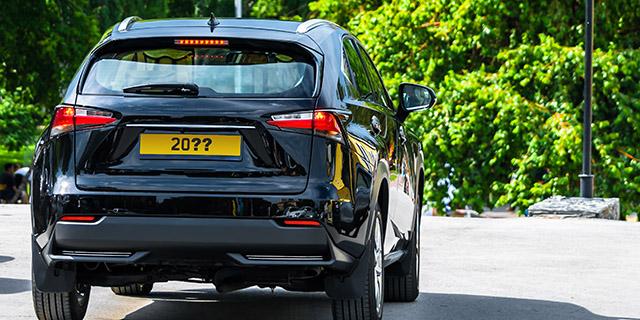For many of us, the only time we really notice number plates is when we’re stuck in a traffic jam, but did you know the letters and numbers can tell you how old the car is and where in the country it was registered? This is why number plates are also known as registration plates.
This quick guide will explain all, helping you to understand all the common questions, including “what year is my car?” “how old is my car?” and “what year is my car reg?” Keep reading for all the number plate info you need.
How do you find out the year of your car?
Every year, two new age markers are introduced – first in March, the second in September.
The March age indicator is easy to remember because it’s the same number as the calendar year – for instance, an ‘18’ reg plate would mean the car was registered in the first part of 2018.
The September number is always 50 plus the year number – for example, a car registered in October 2018 would have an age indicator of ‘68’ (50+18).
So, if you’ve ever wondered “how old is my car?” then just take a look at the two numbers after the area code. The table below shows age markers and their corresponding years (handy to know if you’re after a used car of a particular age).
| Car reg years | 1 March to end August | 1 September to end February |
| 2001-2002 | – | 51 |
| 2002-2003 | 02 | 52 |
| 2003-2004 | 03 | 53 |
| 2004-2005 | 04 | 54 |
| 2005-2006 | 05 | 55 |
| 2006-2007 | 06 | 56 |
| 2007-2008 | 07 | 57 |
| 2008-2009 | 08 | 58 |
| 2009-2010 | 09 | 59 |
| 2010-2011 | 10 | 60 |
| 2011-2012 | 11 | 61 |
| 2012-2013 | 12 | 62 |
| 2013-2014 | 13 | 63 |
| 2014-2015 | 14 | 64 |
| 2015-2016 | 15 | 65 |
| 2016-2017 | 16 | 66 |
| 2017-2018 | 17 | 67 |
| 2018-2019 | 18 | 68 |
| 2019-2020 | 19 | 69 |
| 2020-2021 | 20 | 70 |
| 2021-2022 | 21 | 71 |
Older number plates with the prefix and suffix system
If you’ve been driving for a couple of decades, your first car probably used the prefix system of registration, where a single letter at the front of the licence number designated the year. This was used between August 1983 and August 2001.
Before 1983, the suffix system was used – similar to the prefix format but here the letter indicating the year was at the end. Number plates prior to 1982 are often referred to as the “dateless” format.
The year for prefix and suffix number plates is much less straightforward to work out, as you have to know which letter was used for each year – and some letters weren’t used at all. Here’s a table showing what was used and when:
| The prefix system used between August 1983 – August 2001 | The suffix system used between January 1963 – July 1983 | |||
| Car reg years | Prefix letter | Car reg years | Suffix letter | |
| August 1983 – July 1984 | A | January 1963 – December 1963 | A | |
| August 1984 – July 1985 | B | January 1964 – December 1964 | B | |
| August 1985 – July 1986 | C | January 1965 – December 1965 | C | |
| August 1986 – July 1987 | D | January 1966 – December 1966 | D | |
| August 1987 – July 1988 | E | January 1967 – July 1967 | E | |
| August 1988 – July 1989 | F | August 1967 – July 1968 | F | |
| August 1989 – July 1990 | G | August 1968 – July 1969 | G | |
| August 1990 – July 1991 | H | August 1969 – July 1970 | H | |
| August 1991 – July 1992 | J | August 1970 – July 1971 | J | |
| August 1992 – July 1993 | K | August 1971 – July 1972 | K | |
| August 1993 – July 1994 | L | August 1972 – July 1973 | L | |
| August 1994 – July 1995 | M | August 1973 – July 1974 | M | |
| August 1995 – July 1996 | N | August 1974 – July 1975 | N | |
| August 1996 – July 1997 | P | August 1975 – July 1976 | P | |
| August 1997 – July 1998 | R | August 1976 – July 1977 | R | |
| August 1998 – July 1999 | S | August 1977 – July 1978 | S | |
| March 1999 – August 1999 | T | August 1978 – July 1979 | T | |
| September 1999 – February 2000 | V | August 1979 – July 1980 | V | |
| March 2000 – August 2000 | W | August 1980 – July 1981 | W | |
| September 2000 – February 2001 | X | August 1981 – July 1982 | X | |
| March 2001 – August 2001 | Y | August 1982 – July 1983 | Y | |
So now you know how to work out how old your car is and where it was registered – but do you know what happens when new registration plates are released, or if a private plate will impact your insurance premiums, a quick look at these handy guides and you’ll have all the answers you need.
Why do we have number plates?
UK number plates were introduced in 1903 so that the government had a record of who owned what vehicle – the very first number plates were DY1 and A1. Since then, there have been various different number plate formats. The current format uses a prefix and suffix system.
What country flag can I have on my number plate?
Alongside the numbers and letters you can choose to have a number plate with a country marking as well. Prior to Brexit, the EU flag, or appropriate national flags along with a country identifier are the only things you were officially allowed:
- the EU flag
- the Union flag
- the Cross of St George
- the Cross of St Andrew
- the Red Dragon of Wales.
Presently, if you’re driving in Europe and don’t have an EU flag already on your plate marked with ‘GB,’ you’ll need the classic oval sticker with ‘GB’ on it to be legal on the roads. After Brexit comes into full effect and ties with the European Union are entirely severed, number plates with the EU flag are set to remain legal for driving in Europe if they contain the GB marker.
How can mustard.co.uk help me with my insurance?
At mustard.co.uk we don’t believe in compromising between protection and price so why not start a quote online today?








